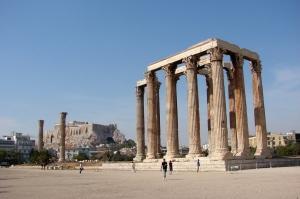Athens Olympieion Archaeological Site
The sanctuary of Olympian Zeus, one of the most important and ancient sanctuaries in Athens, was built, according to tradition, by Deucalion, the first ancestor of the Greeks as a tribute to Zeus for his salvation after the deluge.
 |
|
The Temple of Olympian Zeus in downtown Athens
|
The erection of the large temple was begun by Peisistratos, grandson of the tyrant, in 515 BC, on the site of an earlier archaic temple. Its construction had reached as far as the podium, when it was interrupted by the overthrow of the tyranny in 508 BC. This temple, built of limestone in the Doric style, was huge and modeled on those in Asia Minor. Parts of the building materials were later used for the construction of the eastern side of the Themistoclean fortification wall.
The temple was begun in marble probably in the 4th c. BC, but was never finished. After a long interlude, construction was resumed in 175 BC, financed by Antioch IV Epiphanes, king of Syria, with the Roman architect Cossutius, in Corinthian order. It reached as far as the capitals of the columns. Later it was continued by Augustus and completed by the emperor Hadrian, who also inaugurated it in 131-132 BC.
The temple, one of the largest in the ancient world, had two rows of 20 columns on the sides (dipteron) and three rows of 8 columns at the ends (tripteron). It measured 110,35 m long by 43;68 m wide. It dominated the center of a large rectangular precinct wall which had a propylon on the north. The cella housed the oversized golden and ivory statue of Zeus and the statue of the emperor Hadrian, who were worshipped here as coequals; a great number of statues and votive offerings embellished the precinct.
Deterioration set in during the 5th c. AD and continued during the following centuries due to natural causes and human activities. There was an open-air mosque during the Turkish occupation at the SE corner of the precinct, and on top of the architrave at the SE corner of the temple some structure, perhaps a hermitage or lookout post. Of the original 104 columns of the temple sixteen survived until 1852. In that year one of them was toppled by a terrible storm and has been lying there ever since.
In the same archaeological site, besides the sanctuary of Olympian Zeus the ruins of more sanctuaries are included; they come under the collective name "Ilissian Sanctuaries", as they all were at the banks of Ilissos river. There also exist the ruins of a Roman Valaneion (Public baths) here. Hadrian's Gate is also considered as belonging to this archaeological site, although the very building is outside the site's enclosure. All informative signs, though, are to be found in the site.
Here follows a full list of the antiquities found within this site, numbered as they appear in the informative signs on the spot, shown in the following photos:
1. Temple of Olympian Zeus and the Precinct Wall (124-132 AD)
2. Hadrian's Gate (131-132 AD)
3. Roman Baths (124-131 AD)
4. Remains of Ancient Houses (5th century BC - 2nd centuries AD)
5. Basilica of Olympieion (450 AD)
6. Valerian Wall (256-260 AD)
7. Temple of Apollo Delphinios (450 BC)
8. The Law Court at the Delphinion (500 BC)
9. Temple of Kronos and Rhea (150 AD)
10. Sanctuary of Panhellenios Zeus (131-132 AD)
11, 12, 13. Gates of the Themistoclean Wall (479-478 BC)
|
|



